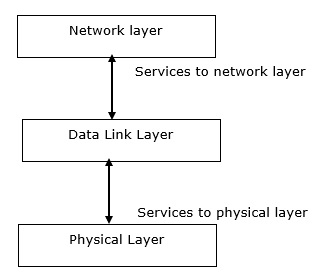
 Data Structure
Data Structure Networking
Networking RDBMS
RDBMS Operating System
Operating System Java
Java MS Excel
MS Excel iOS
iOS HTML
HTML CSS
CSS Android
Android Python
Python C Programming
C Programming C++
C++ C#
C# MongoDB
MongoDB MySQL
MySQL Javascript
Javascript PHP
PHP
- Selected Reading
- UPSC IAS Exams Notes
- Developer's Best Practices
- Questions and Answers
- Effective Resume Writing
- HR Interview Questions
- Computer Glossary
- Who is Who
What are data link layer design issues?
The Data Link layer is located between physical and network layers. It provides services to the Network layer and it receives services from the physical layer. The scope of the data link layer is node-to-node.

The following are the design issues in the Data Link Layer ?
- The services that are provided to the Network layer.
- Framing
- Error control
- Flow control
Services to the Network Layer
In OSI each layer uses the services of the bottom layer and provides services to the above layer. The main function of this layer is to provide a well defined service interface over the network layer.
Types of Services
The services are of three types ?
Unacknowledged connectionless service ? Sender sends message, receiver is receiving messages without any acknowledgement both nodes are using connectionless services.
Acknowledged connectionless service ? Sender sends the message to receiver, when receiver the message it sends acknowledgement to sender that it receives the message with connectionless services.
Acknowledged connection - oriented service ? Both sender and receiver are using connection oriented services, and communication is acknowledged base communication between the two nodes.
Framing
Framing is the function of a data link layer that provides a way for a sender to transmit a set of bits that are meaningful to the receiver.
The Frame contains the following ?
- Frame Header
- Payload field for holding packet
- Frame Trailer
The frame is diagrammatically shown below ?

The following are the three types of framing methods that are used in Data Link Layer ?
- Byte-oriented framing
- Bit-oriented framing
- Clock-based framing
Error Control
At the sending node, a frame in a data-link layer needs to be changed to bits, transformed to electromagnetic signals, and transmitted through the transmission media. At the receiving node, electromagnetic signals are received, transformed to bits, and put together to create a frame.
Since electromagnetic signals are susceptible to error, a frame is susceptible to error. The error needs first to be detected, after detection it needs to be either corrected by the receiver node or discarded and retransmitted by the sending node.
Flow Control
Flow control allows the two nodes to communicate with each other and work at different speeds. The data link layer monitors the flow control so that when a fast sender sends data, a slow receiver can receive the data at the same speed. Because of this flow control technique is used.
Methods for Flow Control
There are two methods are used for flow control, which are as follows ?
- Feedback Based Flow Control
- Rate Based Flow Control

